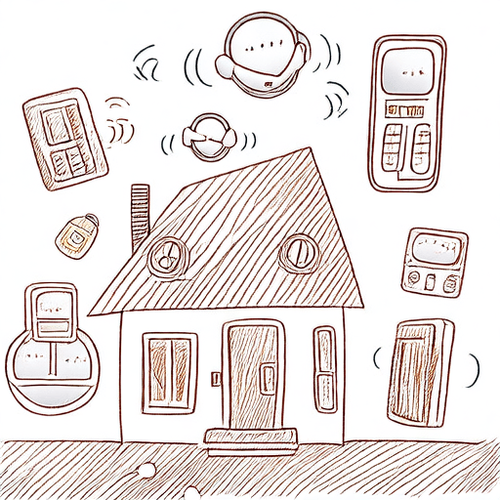Mastering Your Zigbee Network: Integrating zigbee2mqtt with Home Assistant

NGC 224
DIY Smart Home Creator
Introduction: Why zigbee2mqtt?
Home Assistant offers several ways to integrate Zigbee devices, with the built-in ZHA (Zigbee Home Automation) integration being a popular choice. However, another incredibly powerful and flexible option is zigbee2mqtt. This open-source project bridges your Zigbee network to an MQTT broker, allowing Home Assistant (or any MQTT-aware system) to interact with your devices. zigbee2mqtt is renowned for its extensive device compatibility list, often supporting new devices quickly through community contributions. It also provides granular control over device configuration and exposes a rich set of device attributes via MQTT topics.
If you're looking for an alternative to ZHA, need support for specific devices not well-supported elsewhere, or prefer working with MQTT, zigbee2mqtt is an excellent candidate. This guide will walk you through setting up zigbee2mqtt with Home Assistant for a robust and reliable smart home.
Prerequisites
Before you begin, ensure you have the following:
- A running Home Assistant instance.
- An MQTT Broker installed and configured. The Mosquitto MQTT broker add-on in Home Assistant's Add-on Store is highly recommended for ease of use.
- A compatible Zigbee Coordinator. This is a USB stick or adapter that communicates with your Zigbee devices. Popular options include Sonoff ZBBridge (flashed with Tasmota/ESPHome for MQTT), Sonoff Zigbee 3.0 USB Dongle Plus, ConBee/RaspBee, or various CC2531/CC2652/CC1352 based sticks. Ensure your coordinator is supported by zigbee2mqtt and has the correct firmware installed.
- Physical access to your Home Assistant machine to plug in the Zigbee coordinator (if using a USB stick).
Installation and Setup
The easiest way to install zigbee2mqtt on Home Assistant OS or Supervised installations is via the Add-on Store.
Step 1: Install Mosquitto MQTT Broker (if not already installed)
If you don't have an MQTT broker:
- Go to Home Assistant -> Settings -> Add-ons.
- Click on the Add-on Store button (bottom right).
- Search for "Mosquitto broker" and click on it.
- Click "Install".
- Once installed, go to the "Configuration" tab. You likely won't need to change much here unless you need specific security settings.
- Go to the "Info" tab and click "Start". Enable "Start on boot" and "Watchdog".
- In Home Assistant -> Settings -> Devices & Services, search for MQTT. If it's not configured, click "Configure" and use the default settings to connect to the Mosquitto broker add-on (it should auto-discover it). Ensure it's set up to enable discovery.
Step 2: Install zigbee2mqtt Add-on
- Go to Home Assistant -> Settings -> Add-ons -> Add-on Store.
- Search for "zigbee2mqtt" and click on it.
- Click "Install".
- Once installed, go to the "Configuration" tab.
Step 3: Configure zigbee2mqtt
The main configuration happens in the add-on's Configuration tab. You'll edit a YAML file directly.
Key configuration parameters:
data_path: Leave as default (e.g.,/config/zigbee2mqtt).mqtt: Configure your MQTT broker details.base_topic: This is the root topic for all zigbee2mqtt messages (default iszigbee2mqtt).server: The MQTT broker address. If using the Mosquitto add-on, this is typicallymqtt://core-mosquitto:1883.userandpassword: MQTT username and password if required by your broker. Create a dedicated MQTT user if possible.
serial: Configure your Zigbee coordinator connection.port: This is crucial. It's the serial port path for your USB coordinator (e.g.,/dev/ttyACM0,/dev/ttyUSB0). You can often find the correct path in Home Assistant -> Settings -> System -> Hardware -> All Hardware. Look for entries under/dev/serial/by-id/which provide persistent names regardless of which USB port is used (highly recommended).adapter: Sometimes needed depending on your coordinator model (e.g.,zstackfor CC2531,deconzfor ConBee/RaspBee). Check the zigbee2mqtt documentation for your specific coordinator.
frontend: (Optional but recommended) Enable the web UI for easy management.enabled: truehost: Typically0.0.0.0to listen on all interfaces.port: A port number (e.g.,8099).auth_token: Set a secure token or enable username/password authentication for access.
permit_join: Set totruetemporarily to allow new devices to join the network. Set tofalsewhen done pairing.homeassistant: Ensuretrueto enable MQTT discovery for Home Assistant.
Save the configuration.
Step 4: Start zigbee2mqtt
Go back to the zigbee2mqtt add-on's Info tab. Click "Start". Enable "Start on boot" and "Watchdog". Check the "Log" tab to ensure it starts successfully and connects to the MQTT broker and your coordinator.
Step 5: Access the zigbee2mqtt Web UI (Optional but Recommended)
If you enabled the frontend, you can access it via http://[your_home_assistant_ip]:[frontend_port]. This UI is invaluable for managing devices, viewing the network map, and configuring device-specific settings.
Integrating Devices
With zigbee2mqtt running and connected to Home Assistant via MQTT discovery, paired devices will automatically appear in Home Assistant.
Step 1: Enable Pairing
In the zigbee2mqtt web UI (or by setting permit_join: true in the add-on config and restarting), enable joining for new devices. The UI has a button for this.
Step 2: Put Device into Pairing Mode
This varies significantly by device. Common methods include holding a button for 5-10 seconds, powering the device on/off multiple times, or following specific instructions in the device manual. Look for a blinking light indicating pairing mode.
Step 3: Monitor Pairing
Watch the zigbee2mqtt log or the web UI. You should see messages indicating a new device joining. Once joined, it will appear in the zigbee2mqtt UI and be published to MQTT.
Step 4: Device Discovery in Home Assistant
Thanks to MQTT discovery, the new device and its entities (lights, sensors, switches, battery levels, etc.) should automatically appear in Home Assistant under Settings -> Devices & Services -> MQTT integration. You may need to wait a minute or two.
Device Configuration and Customization
One of zigbee2mqtt's strengths is its configurability.
- Via Web UI: In the zigbee2mqtt frontend, you can click on a paired device to view its exposed features and configurations. You can often adjust reporting intervals, binding, and specific device options directly here.
- Via
configuration.yaml: For more advanced settings or device-specific converters, you can edit the add-on's configuration YAML. Refer to the zigbee2mqtt documentation for your specific device model to understand available configuration options. - Naming: Rename devices and entities in Home Assistant after they are discovered for easier identification.
Building a Reliable Zigbee Network with zigbee2mqtt
A stable Zigbee network is key to a reliable smart home. Here are some best practices:
1. Location of the Coordinator
Place your Zigbee coordinator centrally if possible. Avoid placing it directly next to Wi-Fi routers, USB 3.0 ports, or other sources of 2.4GHz interference. Use a USB extension cable (especially a shielded one) if plugging directly into your Home Assistant machine to get the coordinator away from the computer's EMI.
2. Utilize Router Devices
Zigbee networks operate as a mesh. Mains-powered Zigbee devices (like smart plugs, always-on light bulbs, wired switches) act as routers, extending the network range and providing alternative paths for communication. Ensure you have enough router devices spread throughout your home, especially between your coordinator and battery-powered end devices (which don't route).
3. Choose a Good Coordinator
Not all coordinators are equal. Newer, more powerful coordinators with better antennas and chips (like those based on CC2652P/CC1352P or modern Sonoff sticks) generally handle larger networks and interference better than older ones (like the basic CC2531).
4. Keep Firmware Updated
Regularly update the firmware on your Zigbee coordinator and the zigbee2mqtt software. Updates often include bug fixes, performance improvements, and support for new devices.
5. Manage Your Network Map
The zigbee2mqtt web UI provides a network map. Use it to visualize your mesh network, identify devices that are struggling to connect (often shown with weak links or not connected to a router), and diagnose potential dead spots.
6. Avoid Mixing Zigbee Stacks if Possible
Running multiple independent Zigbee networks (e.g., ZHA and zigbee2mqtt) on the same channel can cause interference. Stick to one primary Zigbee integration/network if possible. If you must run multiple, ensure they are on different, non-overlapping channels (check your Wi-Fi channels too!).
Troubleshooting Common Issues
- Device won't pair: Ensure
permit_joinis true. Try resetting the device according to its manual. Ensure the device is within range of the coordinator or a router. - Device drops off: Check the network map. Is it connecting through routers? Do you have enough routers? Is there interference? Try re-pairing the device near the coordinator.
- Commands are slow/unreliable: This is often a sign of a weak mesh network. Add more routers or improve coordinator placement.
- Add-on won't start: Check the add-on logs. Common issues are incorrect serial port paths or configuration errors.
Conclusion
Integrating zigbee2mqtt with Home Assistant provides a robust, flexible, and highly compatible way to manage your Zigbee devices. While it requires a bit more setup than ZHA, the benefits of broader device support, detailed configuration options, and a strong community make it a compelling choice for many users. By following the setup steps and implementing best practices for network management, you can build a highly reliable Zigbee network for your smart home.

NGC 224
Author bio: DIY Smart Home Creator
